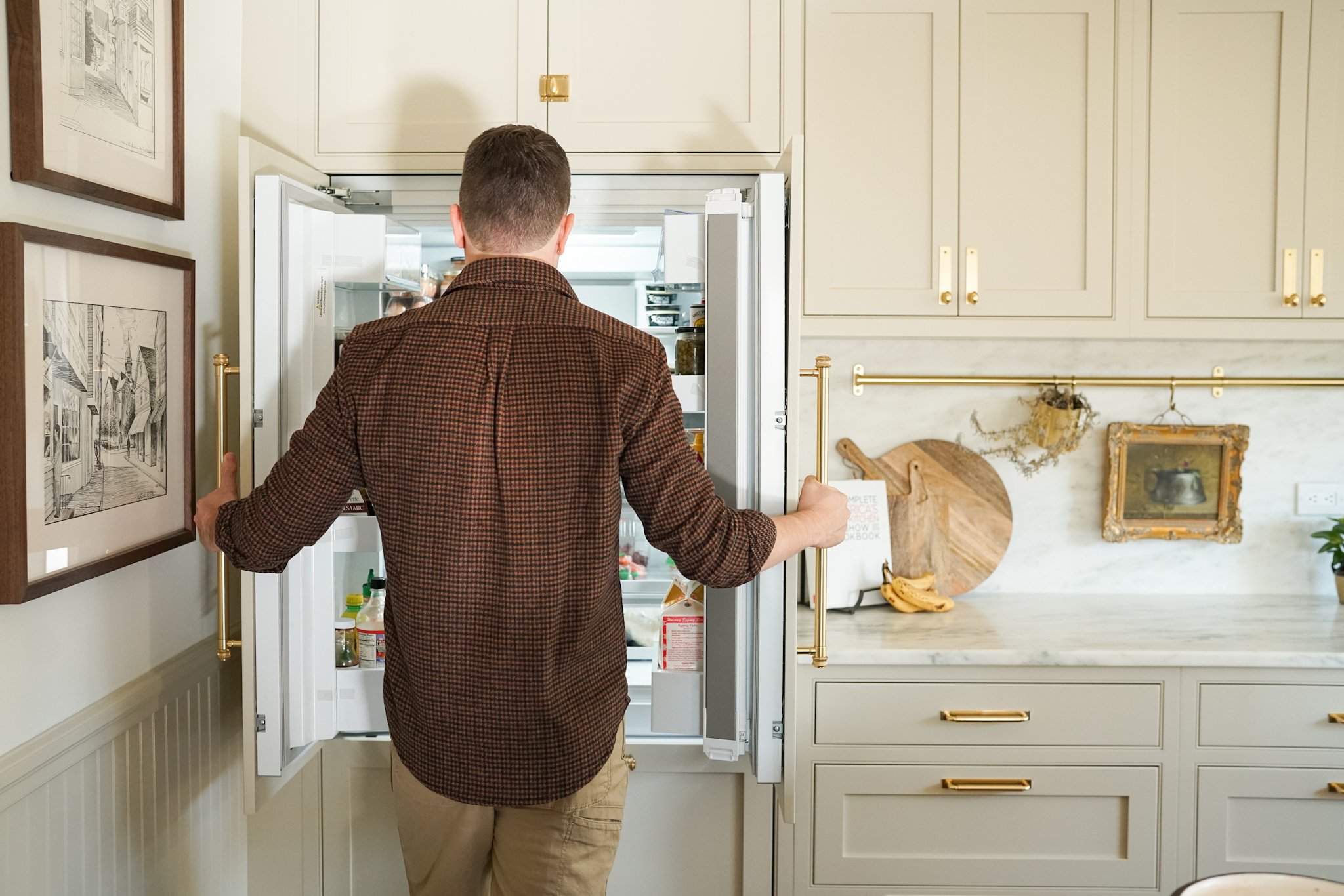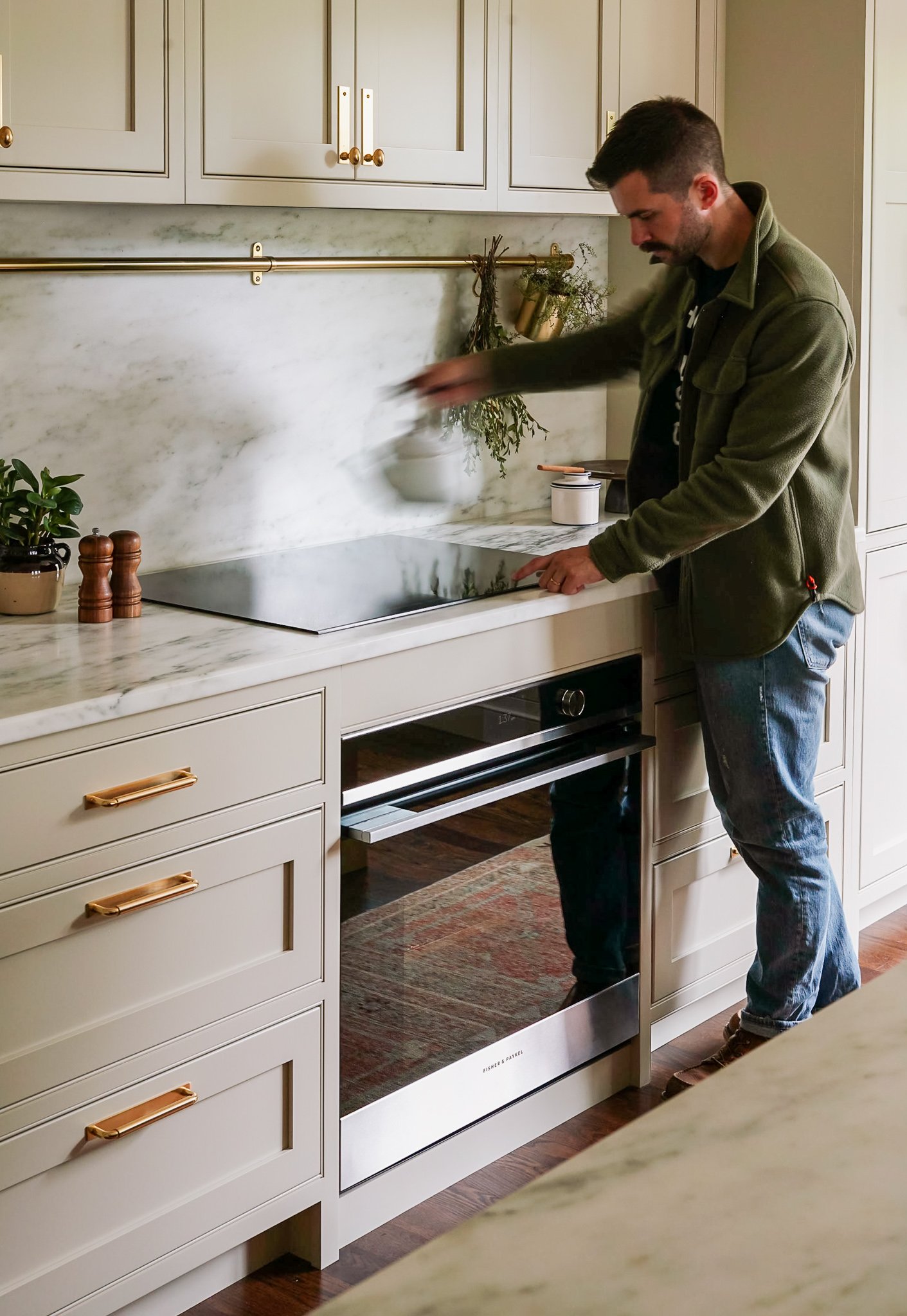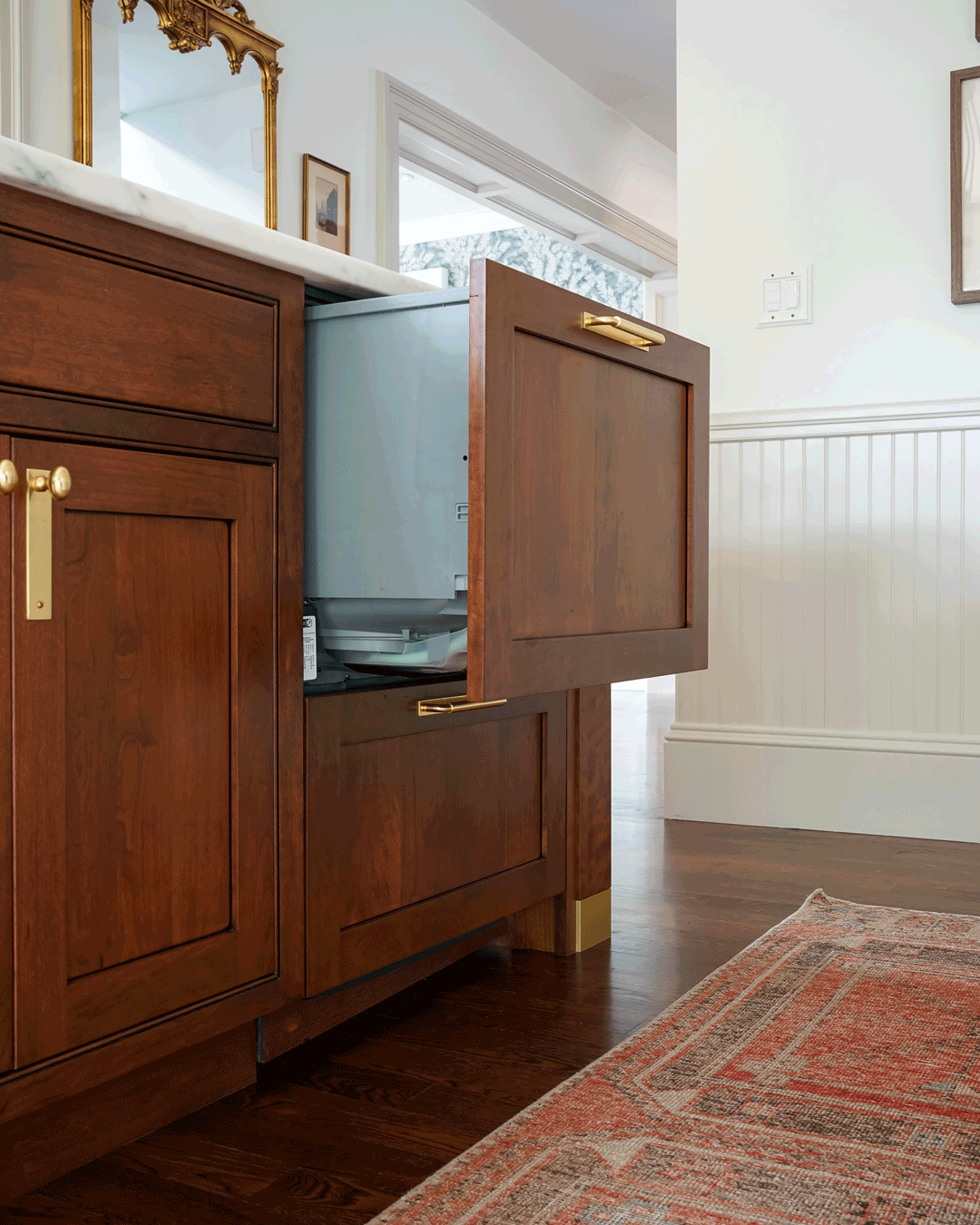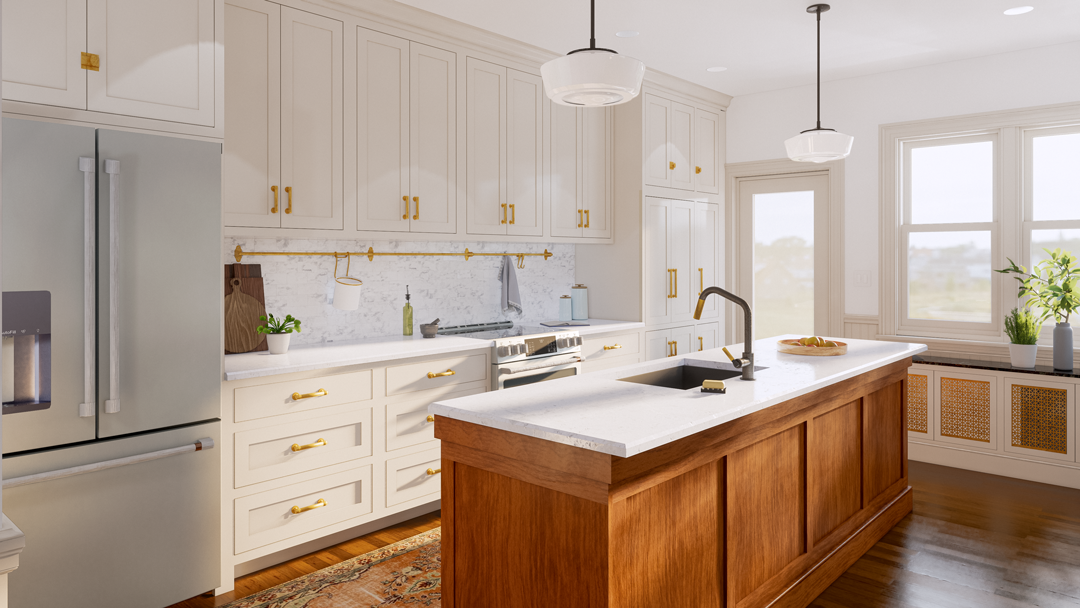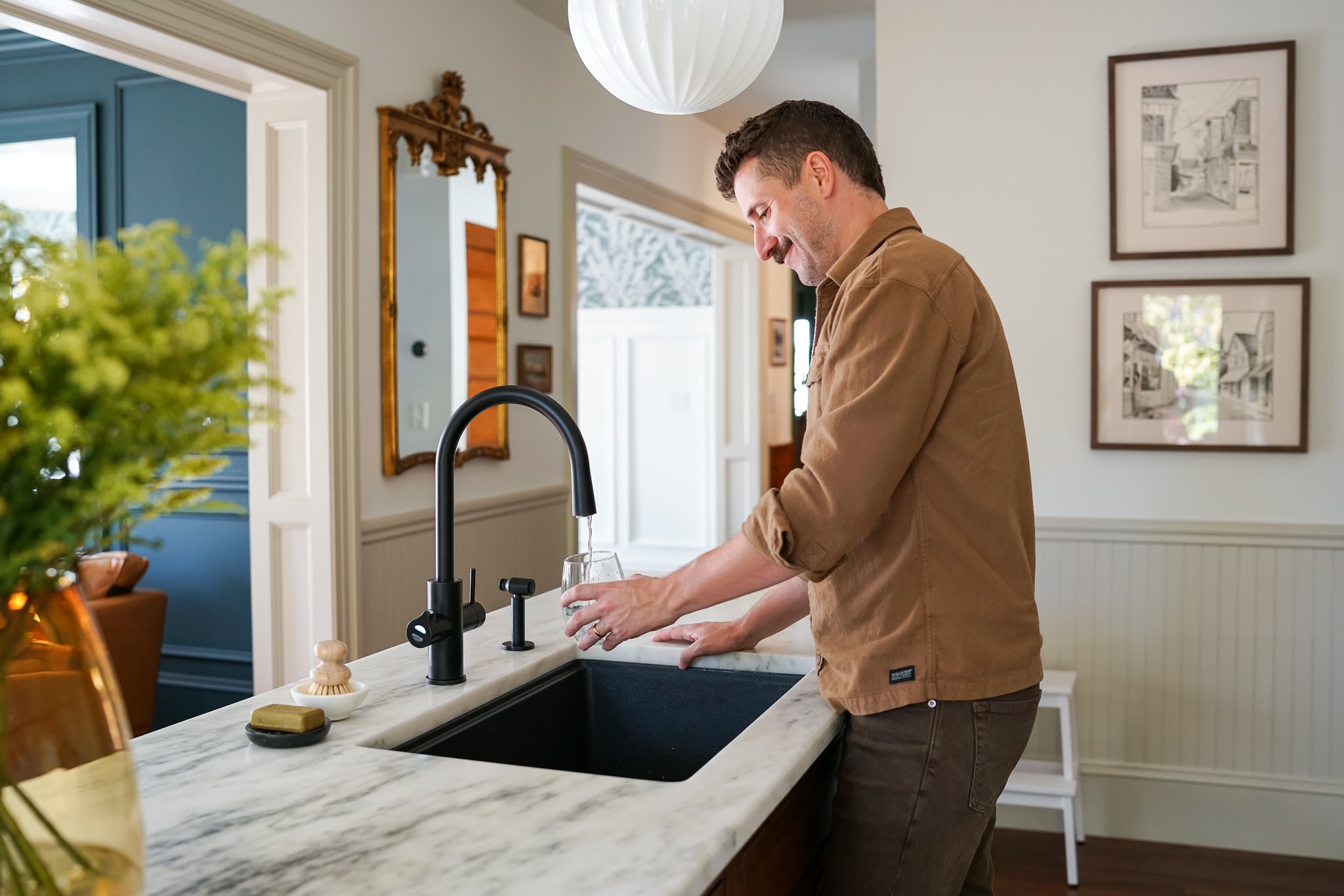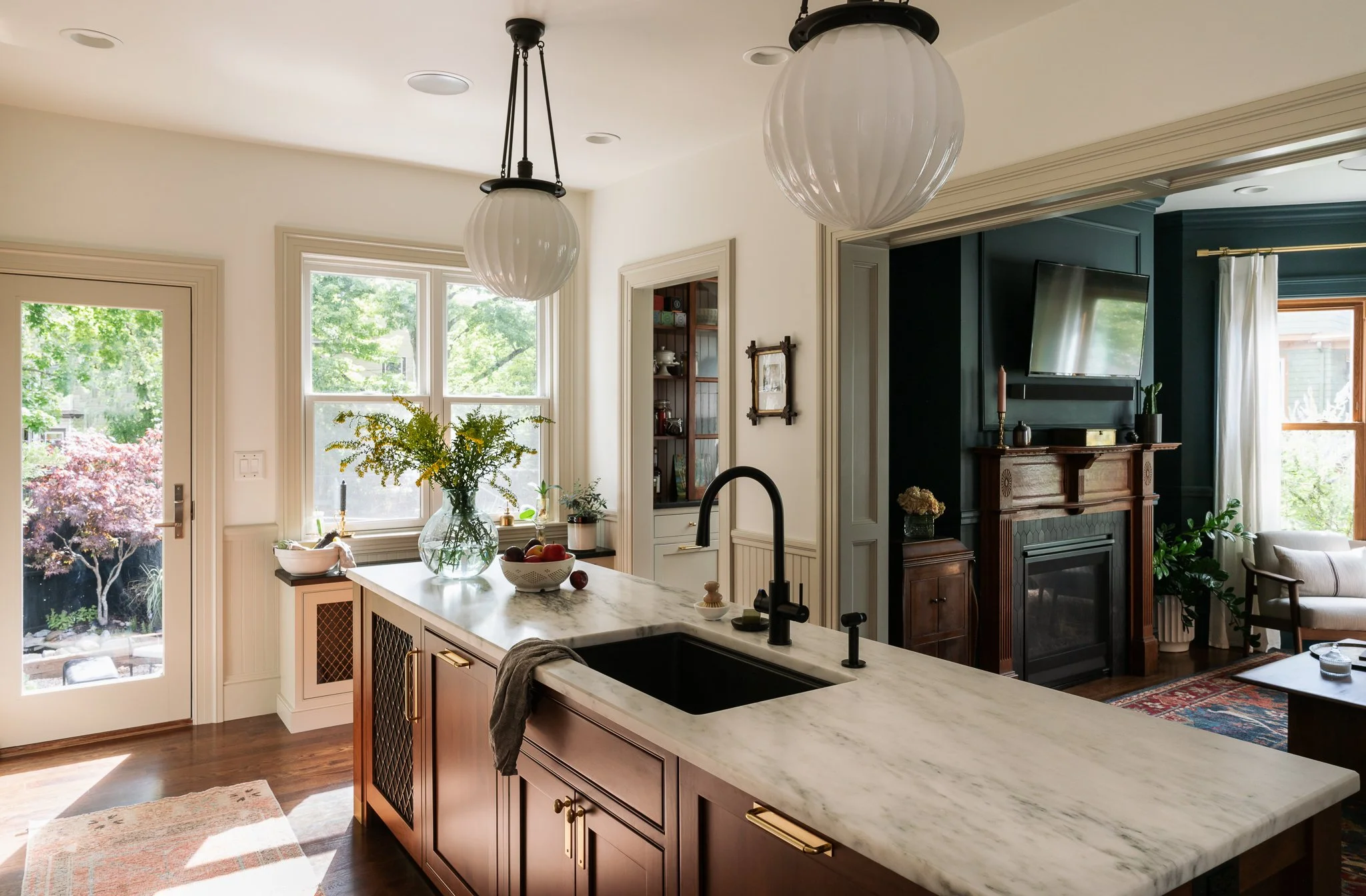Our Fisher & Paykel Appliance Review
Our path to choosing new kitchen appliances was long and winding. We decided from the beginning to put aside any of our own preconceived notions, and shop with an open mind. We also knew that we did not need a single brand solution - but instead felt fine mixing and matching brands in order to best suit our needs.
// Yale Appliance
We took a trip to our local Yale Appliance store and perused the aisles, oohing and awing over some of the most beautiful appliances we had ever seen. Some of the refrigerators could be confused for small rooms - and for whatever reason we found that to be equal parts amazing and comically unnecessary. We have never seriously shopped for appliances outside of Home Depot or Lowes and it was really an entirely new (and superior) experience. After a bit of wandering we began working with a Yale employee who gave us a complete overview of the appliance landscape. That first scouting trip was so informative and really helped with our decision making process. Even better - we felt zero pressure to buy anything at all.
// Disclosure
We decided to use Fisher & Paykel appliances exclusively for this project because they were the best fit for our needs. We made this decision prior to reaching out to the brand for a potential collaboration as part of our Kitchen Renovation. As part of our agreement we received a discount in exchange for sharing our experience on Instagram. This blog post was not required and the opinions expressed are our own.
If you are new to New Zealand's Fisher & Paykel, they are known for their higher-end models across the appliance landscape. Each product is designed according to their "Social Kitchen" theory. They aim to create modern designs that fit into a variety of spaces and layouts so that the kitchen is not only about cooking, but about being together, too. So cool!
The Refrigerator
When choosing a refrigerator we had two basic requirements: we were limited to 36” due to layout and it had to be integrated. Oh! and we didn't want door ice or water dispensers.
// Integrated appliances are “panel ready” and designed to sit in the same plane as the rest of your cabinets. You receive an unfinished refrigerator door and mounting hardware - allowing you to mount a panel that blends in with the rest of your cabinetry. The greatest sacrifice you make is slightly less space inside the appliance - the appliance needs to be smaller than counter-depth models and standard depth alternatives. Going this route was no more than a design choice. For us, there has been plenty of food storage space, but for a household with a larger family (or maybe people who cook more often than us), a counter-depth fridge might be the way to go.
Because we were only looking at built-in models, our options were narrowed down quickly. They tend to be made by higher end brands, with a steeper price range, and fewer features. More than once did I (David) ask - are you SURE we can’t just go counter depth?! - followed by Stephen denying my request in the name of design. In the end, he was correct in his decision for this project… again.
// Fisher & Paykel
It didn’t take us long to arrive to the conclusion that Fisher & Paykel was the brand for us. The Fisher Paykel refrigerators are not only gorgeous, but superior in quality and, in the world of integrated appliances (and our opinion), the best.
When our new refrigerator was delivered, we couldn’t get it out of the box fast enough. In fact, for the first couple of months, it sat operating while still bolted down to its shipping pallet. Even so, we had never felt fancier or more excited to use a new appliance. The experience stood apart - it is beautiful, bright, quiet, and features a high quality interior. We set up our food like we were about to film an episode of MTV Cribs and sent photos to our moms.
We have always preferred the french-door models with the bottom freezer drawer and our new ice maker has more than kept pace with our cold brew and smoothie habits. The pull-out basket is really easy access and we never seem to run out - no matter how much coffee we're consuming that week!
The Fisher & Paykel refrigerator without finish panels.
// Panel installation was performed by our cabinet installer Ian while we nervously hovered over his shoulder. Panel-ready refrigerators are notoriously picky, but according to Ian, this is one of the best he has worked with. We sighed with relief…
After months of use, we can confidently say that we are very pleased with our new fridge freezer. More importantly, we have no concerns about how the fridge door panels are performing with consistent daily use - they feel solid when pulled and there is no indication that they will fail anytime soon. The integrated refrigerator sits flush in its opening and is very easy to roll forward if needed.
Refrigerator Details
Custom panels made by Cabinet Joint
Hardware by Rejuvenation
Installed by Ian
Cooktop & Wall Oven Combination
Don’t worry! We are going to talk about these independently BUT we first want to mention why we chose a cooktop and wall oven combination instead of a slide in range.
Fisher & Paykel Cooktop and Wall Oven Combination
Just like with our refrigerator, we were limited by the layout. No matter how many different configurations we tried, we could not increase the oven space from 30” to 36”. Each variation presented itself with too many compromises elsewhere in the design and we decided that 30” was the best option.
Once we understood our constraints, and eliminated the standard 36-inch-wide models from our search, we were left with another decision. The combination version would continue our integrated look, while a slide in range would provide a prominent focal point as well as break up our large wall of cabinets. The range option is also more cost effective - you pay for 1 appliance, rather than 2 and only need a single power supply. For us the deciding factor was capacity - the wall oven has a significantly larger capacity than the range of the same size.
We embraced the continuation of our integrated design and decided that a slide in range looks more attractive when its 36” anyway. A few months in and we are so much happier with our combination solution than any range we have had in the past.
Induction VS Gas
//FAQ: Why did you switch from gas to induction?!?!
Changing from gas to induction surprised a lot of people. Induction is like that new kid on the block who might be cool but we just are not sure how we feel yet. This paired with decades of hearing “now we are cooking with gas” really left a lot of people stumped about our decision. After all, conventional thinking would lead you to believe that cooking with gas is the best. And to be completely honest - we were a bit nervous about the cost of jumping into a technology that we were not familiar with.
We can now confidently say - switching from gas to induction was 100% the correct decision for us.
There are a lot of reasons thrown around about the superiority of induction cooktops. However, for us, one of them stood above the rest: we absolutely loathed cleaning our gas range. Every dinner was followed by rage as we had to disassemble the grills (inevitably scratching the sink) and all those other metal parts in order to clean the caked on food or the puddle left by the over-boiled pasta. Unfollow, unsubscribe, no thank you, it is the worst - or as I would often proclaim during the process “this is for the birds”.
Switching to induction reduces our dependence on natural gas, increases our energy efficiency, and is overall healthier, but best of all, we have an easier cleanup. We seriously cannot overstate how much we hated cleaning our previous stovetop. Our new cooktop by comparison is an absolute delight. It only gets as hot as the pot sitting on it (magnets are magic) so nothing bakes on the surface. We spray, wipe, and done. 10/10 would recommend.
With all of these amazing pros there must be some cons? Well, induction is more expensive (for now), and if the power goes out your oven no longer works. Also you need induction ready pots and pans (all of ours were already compatible, including our dutch oven). Some brands, including Fisher & Paykel, have combination gas/induction cooktops if that’s an appealing compromise for you!
Enough about that, we stan induction.
The Cooktop
Can we talk boiling speeds for a moment? So fast. When people come over and ask about the cooktop we put on a pot of water and tell them to watch it boil - and they don’t have to wait long. It’s impressive enough to say “woah” out loud.
// Cooking
General cooking has been great and we have not found ourselves missing the “control” of cooking with gas. We do find the lower cooking temps harder to gauge than the higher cooking temps because they feel less responsive comparatively but not enough to be annoyed. Also, important to note, because the magnets are hard at work you can hear them jiggle (I don’t know how else to describe the noise) but not nearly loud enough to be an issue. We have grown accustomed to both of these things and really enjoy the experience. Otherwise - it is a stove and it makes the pan hot - not overly complicated.
// Cleaning
We typically wipe it with Windex Vinegar (not sure if this is recommend but I use it on everything and there is no stopping me now). We also use this cleaner and polish product occasionally which works way better than expected - we were both really impressed.
// Scratching
We were initially worried about scratching the glass cooktop and bought these silicone pads for under our cookware. The magnets have no problem working through the silicone and they easily handle the heat. Even better, they are dishwasher safe. In the end we learned that the glass is a lot tougher than we thought and our anxiety about scratching has gone away - we have basically stopped using the pads - even when using our favorite enameled cast iron dutch oven.
// Ventilation
Once again we took the integrated route for our hood. The cabinet above the stove houses an Insert Range Hood by Fisher & Paykel. There is still plenty of room to house cooking oils or spray and a couple of other items! We have used integrated hood in the past and really like when it’s hidden. Many people prefer to feature their hood, but it’s just not for us, especially at 30”.
It’s important during this step to check with your inspector to see what is acceptable as there seems to be a big variation in local codes. With induction the ventilation requirements may be less vigorous than that of gas which has an open flame.
// Takeaways
You guessed it, it was worth the switch for the cleaning alone. We are really happy with our decision and will likely continue to use induction in the future.
Cooktop Details
The Oven
At risk of saying everything is great… the oven is pretty great - and it’s also beautiful.
// Capacity
The capacity is really nice for a 30” oven and our primary reason for choosing the wall unit over the slide in range. We have been cooking full chickens like crazy (more on this later, maybe) in our dutch oven and have no problem fitting it along with a few other items. The racks slide easily on fancy tracks and fully extends like a cabinet drawer. We cannot wait to get a turkey in this thing - that will be the ultimate performance test!
We gave up on trying to remove the dust for this photo.
// Cooking
Stephen loves to talk about how many cooking functions this thing has. Fisher & Paykel lists 17 functions which we think is kind of funny/ambitious but it certainly does more than any oven we have ever owned. The display walks you through all of the different modes - aero bake, aero broil, air fry, bake, broil, classic bake, and the list goes on. As not super serious cooks we use about 3-4 of the modes consistently, and mostly guess what the other modes might do - sometimes selecting one just for fun.
// Air Frying
Hands down, this is the mode we looked forward to trying for the most. We have never owned an air fryer and people love their air fryers. If you don’t know - air frying is baking but with a lot of air circulation, reducing the moisture content of the food and making it crispy (feel free to correct me if I am wrong). Let me tell you - it works - and its amazing. We have spent multiple nights thinking up things to air fry and have not been disappointed yet.
// Food Probe
We were also really excited to cook by optimum temperatures, rather than time. Cooking to temperature seems like it would be a superior method of cooking, and we dove right in. While F & P created an interface for choosing your type of meat and desired temperature (Beef - Medium Well, for example), I have found the experience to be very frustrating when trying to cook using your own recipe.
I want the oven to treat the probe like it treats the timer function, but instead of time, internal temperatures. I want to set it to a target temperature, and get notified with a chime when achieved. This oven just doesn’t do that - you have to use the food selector. Lastly - if the probe is plugged in, I want to see the temperature on the screen no matter what. Overall, I am pretty disappointed by this.
// Takeaways
The ovens capacity is great, its bright, and the hardware is really high quality. It easily does everything we need and more - including our favorite thing ever - air fry. The food probe situation is really annoying but not enough to keep us from recommending this appliance.
Oven Details
Dishwasher
Folks, we recommend sitting down for this one. We present to you: the Fisher & Paykel double drawer dishwasher.
Never have we ever heard of something like this until we toured the Yale Appliance showroom. The Yale employee was excited about this one, and we now fully understand why. Each drawer is independently owned and operated - which is how we say that each drawer functions independently - and the entire experience is magical.
The drawers are essentially two plastic tubs that are configured in an intelligent way for washing dishes. They slide out, unlike the hinged washers of yesteryear, for easy loading and unloading and really do a great job. We've had no problem accommodating all of our dishware, including tall items, into these drawers.
// Performance
We do rinse our dishes quickly before putting them in and the appliance does a really great job taking care of the rest. We do find that rinse aid helps a lot but we think this is true with any dishwasher. Overall 10/10.
// Operation
The buttons make enough sense but we found that the sequence of beeps and boops could be more intuitive. We have since become accustomed to its quirks and have no issue with operation. When the dishwasher is running the drawer locks, but it can easily be paused (unlocked) by a double knock on the front (Stephen thinks this is super cool).
// Noise
We were told that the dishwasher is not the quietest on the market - but we already had a plan in place. Long before choosing a dishwasher we insulated the island with Rockwool Safe’n’Sound insulation which significantly cuts down on noise level - in fact, we can barely hear it at all. We are glad we took this extra step.
// Takeaways
The biggest difference here to a standard dishwasher is obviously the double pull-out basket. We find it to be super helpful and we love washing smaller batches of dishes. We really do recommend it, and would easily choose it again to use in future projects.
// Bonus Cooler
We also learned at Yale that you can take the rack out and fill the drawers with ice - doubling as a cooler when having a party. While we don’t know if this is brand recommended, we can’t wait to give it a try.
Dishwasher Details
Custom panels made by Cabinet Joint
Hardware by Rejuvenation
Final Thoughts
There are a lot of factors that contribute to choosing the correct appliance for your project. Of course you want them to fit into the design of your home, but they also have to meet all of your cooking and cooling needs. We found that a trip to our local appliance distributor - reviewing similar models and really getting the feel of each - to be extremely helpful in making our final decision.
We didn’t know much about Fisher & Paykel prior to starting this process but quickly fell in love with the brand and their high-end features. Our experience thus far has been exceptional and we are so happy with the choices we made.


